Soundwave
Sound is energy in motion
- when someone hits a drum with a stick, energy is being converted from one form to another.
- when the arm is lifted, the body is giving it potential energy. When the arm moves toward the drum, it has kinetic energy. As the stick strikes the drum, the drumskin sucks up most of the energy and starts to vibrate. Since that drumskin is now the thing that is moving, it now has the kinetic energy, so it starts to vibrate. As that skin vibrates, it pushes air molecules that are in contact with it. Each moving air molecule pushes its neighbors, creating a ripple effect until all the air molecules in the room are vibrating. Inside your ear, the vibrating air molecules make tiny hairs vibrate. The hairs stimulate nerve cells, which send signals to your brain—and your brain perceives these signals as sounds.
Two key properties of a sound determine how it sounds
- The frequency (how many times the wave vibrates in one second) is broadly related to the pitch of the sound we hear. So we hear a high-frequency sound as having a higher pitch. In other words, a choir boy's voice produces a mixture of sound waves of generally higher frequency than an adult man's voice.
- The amplitude (volume) of a sound is related to the amount of energy that the sound waves carry. When you bang a drum hard, you make more energetic sound waves with more amplitude that you hear as louder sounds.
The intensity of a soundwave is the power transmitted across unit area.
- therefore, we can obtain a rough estimate of the intensity at the sound source (e.g. a trombone bell) by dividing the total radiated power (P) by the area of the bell.
Properties of a soundwave
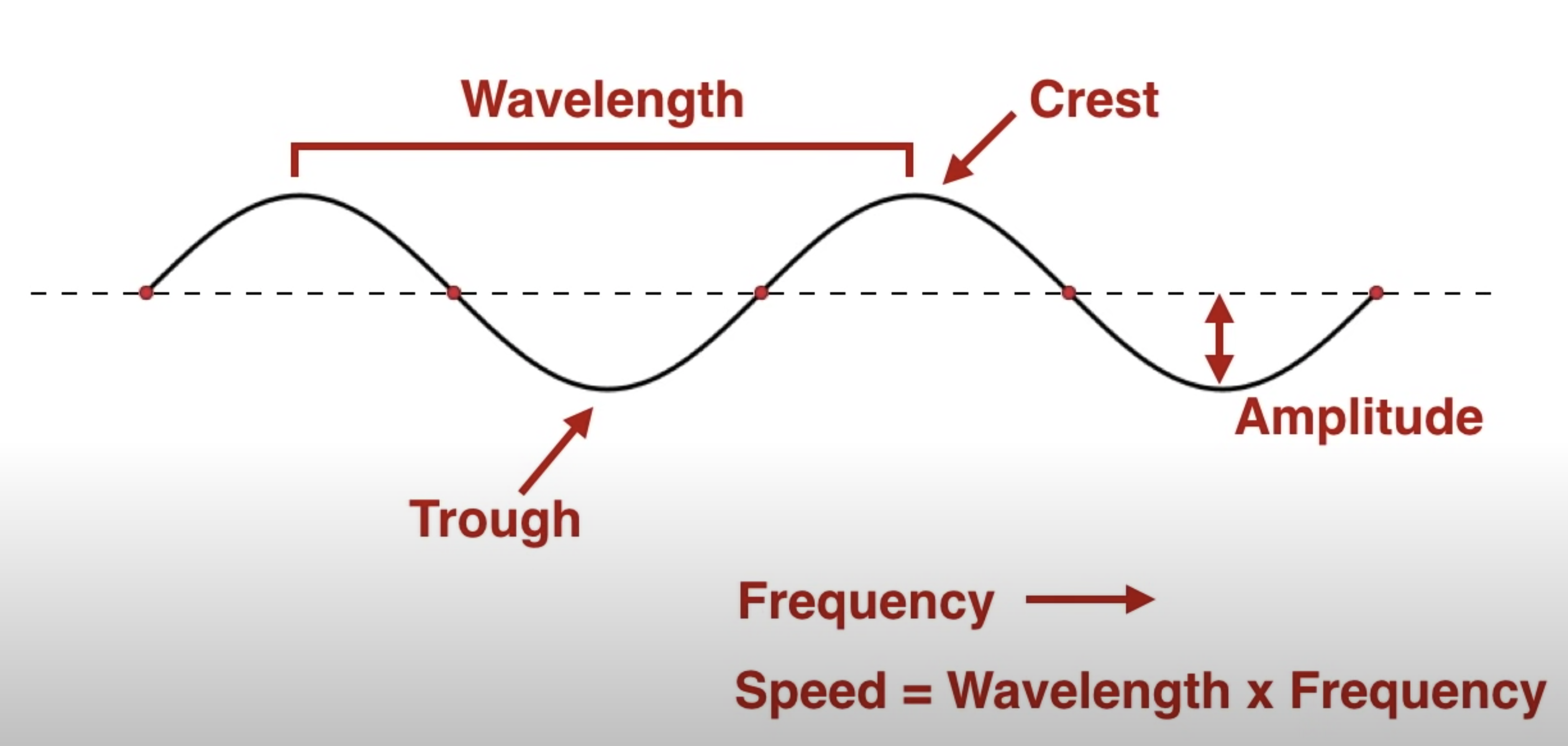
We hear multiple frequencies, but the main one we hear is the fundamental.
- All sounds can be broken down by each individual sine wave (singular frequency) that builds it.
- ex. The reason why a clarinet playing middle C sounds different from a piano playing middle C is because the frequencies that make up each sound are different. The notes are the same, the frequencies (harmonics) are different.
- therefore, the fundamental of a clarinet playing C sounds the same as the fundamental of a guitar playing C.
The only time you hear a single pitch is if you are listening to a sine wave. Every instrument and wave form has some kind of overtones which result in the distinctive timbre of said instrument which makes it identifiable.
Harmonics
| Harmonic | Frequency | Pitch |
|---|---|---|
| 10th | 4400Hz | C# |
| 9th | 3960Hz | B |
| 8th | 3520Hz | A (3rd octave) |
| 7th | 3080Hz | G 1/4 flat |
| 6th | 2640Hz | E |
| 5th | 2200Hz | C# |
| 4th | 1760Hz | A (2nd octave) |
| 3rd | 1230Hz | E |
| 2nd | 880Hz | A (1st octave) |
| Root (Fundamental) | 440Hz | A |
When we play an A note on the guitar (the fundamental), there are also other harmonic sounds that can he heard, each of which is a perfect multiple of the fundamental frequency
Certain combinations of odd numbered harmonics (e.g. 3rd, 5th and 9th(?)) will tend to product a more edgy sound, while the even harmonics will create a more soothing sound.
Overtone
Overtones are the strongest at the moment of attack. So if the attack is covered by the rest of the ensemble, and the note is sustained, it can be difficult to tell what instrument is playing the note. In other words, if a clarinet plays a sustained note, but the entire ensemble hits a loud short note at the moment of attack, it will be difficult to tell if the sustained note is played by a clarinet or a trumpet or an oboe or a flute, etc.
- if you had a chorus of singers singing a chord in perfect tuning, you would hear a tone that is not being sung by any one of the singers. This tone is the overtone.
- ex. Stravinsky does it in The Rite of Spring
Soundwaves are longitudinal
when the soundwave has a constant vibration (such as one originating from an instrument), the movement of the air molecules will disturb those ahead and behind them in such a way that they cause molecules to squeeze together
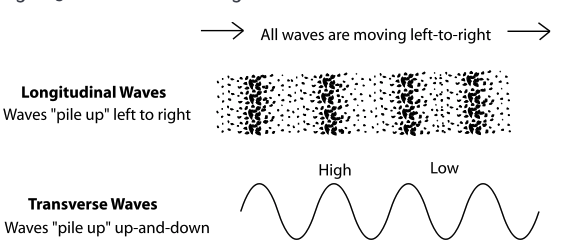
- This type of wave is difficult to show in a diagram, which is why sound waves are portrayed as transverse
- A slinky creates waves similar to this
- try imagining yourself as one of the particles that the wave is disturbing (a water drop on the surface of the ocean, or an air molecule). As the soundwave comes from behind you, its transverse waves lift you up and then drops you down; a longitudinal wave coming from behind pushes you forward and pulls you back.
- When we are portraying a longitudinal wave as transverse, the "high point" of the wave would be when the molecules are more bunched together.
- when playing a guitar, the string disturbs the air molecules around it as it vibrates, producing sound waves in the air
Standing Wave
- Standing refers to the fact that the peaks of the waves don't move toward a direction — though the amplitude does go up and down
- this phenomenon arises when we confine a wave to a given region. we have a string fixed at both ends. When you pluck a guitar string, the wave travels down the string towards the nut. Once it hits the nut, it reflects back toward the base, though going down the reverse side of the string. Because these waves are continuous, they run into each other at the nodes (where the wave meets the center axis). Standing waves occur when these waves running into each other reinforce one another, as opposed to crashing into each other.
- The deal with standing waves is that they have to fit perfectly within the boundaries so that the reflected wave will match up perfectly with the nodes that correspond.
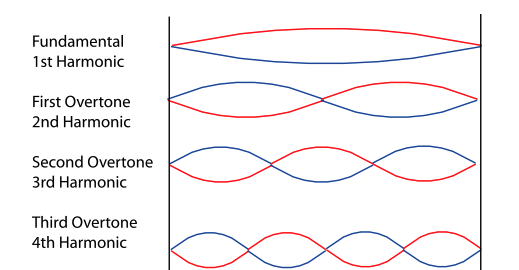
- These standing waves are called harmonics.
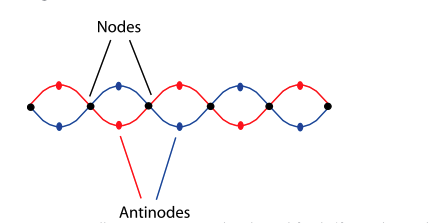
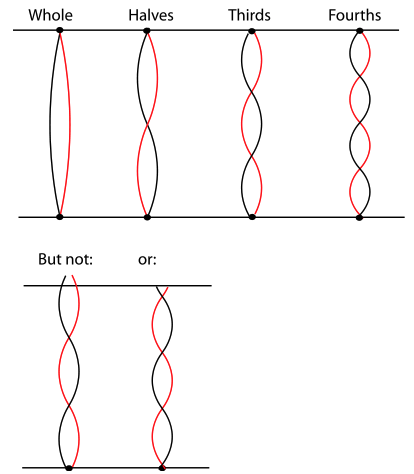
-
The longer the string, the longer the wavelength. With a stringed instrument, the only way to get shorter wavelength harmonics is to shorten the string by fretting. This is how you move from whole to halves to thirds and so on.
-
when you think about it, the with each harmonic, we are dividing the string into 1/2, 1/3 and so on.
-
The fundamental (whole) wave is the one that gives the string its pitch. the other waves produce a series of harmonics.
-
They are what gives the string its rich, musical, string-like sound - its timbre.
- (The sound of a single frequency alone is a much more mechanical, uninteresting, and unmusical sound.)
-
Anything that produces a tone (ie musical instrument, voice)
Phasing
"phase" describes how in-sync soundwaves are with each other.
- how off-set the waves are with each other can be described in degrees
- 0° means perfectly in phase; 180° means out of phase.
- when out of phase, the 2 soundwaves will cancel when mixed together, making no sound ("phase cancellation").
- when in phase, the 2 soundwaves will reinforce each other and the result will be louder.
- 0° means perfectly in phase; 180° means out of phase.
The phase cancellation between two signals matters more for lower freqency sounds.
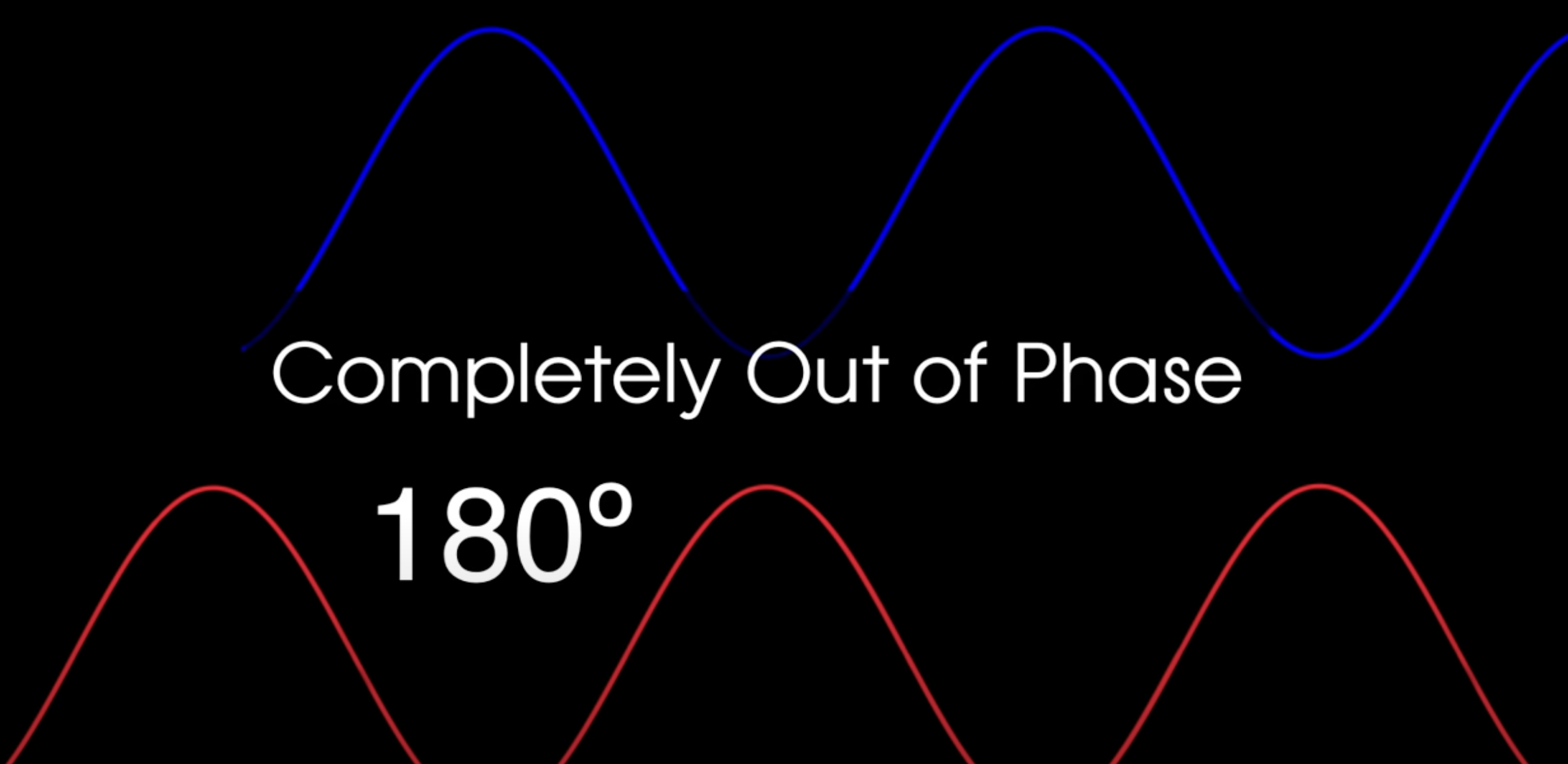
To illustrate phase, imagine we had 2 floutists and a single overhead microphone. Assuming they are both playing the exact same note, the same (more or less) soundwave should emanate from each flute. If the waves from both flutes arrive at the microphone in phase (that is, the peaks and troughs from both soundwaves appear at the same time), then the result will be a doubling of amplitude. When both instruments play together, the variation in pressure at the microphone's diaphram due to the second flute will be added to the one from the first flute (constructive interference). However, if the 2 soundwaves hit the microphone completely out of phase, then the sound will disappear. As the soundwave from flute 1 tries to make the air pressure rise, the soundwave from flute 2 is trying to make it drop. This effect repeats as the soundwave from flute 1 tries to make the air pressure drop, while flute 2's soundwave tries to make the pressure rise. The net effect is that the 2 waves cancel each other out completely, and the microphone records only silence (destructive interference)
- this rarely happens so starkly in reality. For starters, we have ignored the soundwaves that have bounced off the walls and have arrived at the microphone.
Beating
When two slightly detuned pitches are playing, we get the wobbly beating effect. The more out of tune the sound, the more the beating. This effect happens due to phase. The higher pitched sound has a higher frequency, and thus shorter soundwaves. When plotted against the lower pitch, what will happen is that sometimes the peaks are lined up, resulting in a higher amplitude (constructive interference). Moments later, the peak of one sound will match up with the trough of the other sound, resulting in lower amplitude (destructive interference). This effect repeats constantly, resulting in the beating effect which is fundamentally similar to tremolo.
- as the instruments are tuned closer to each other's pitch, the beating slows down due to the fact that the alignment of peaks and troughs occur at more spaced intervals.
- by counting the number of beats per second, the frequency difference between 2 pure tones can be estimated
- ex. if we have a tone of 100hZ playing against a tone of 103hZ, in one second the higher pitch will have gone through 3 cycles more than the lower pitch, generating 3 cycles of beating.
Doppler Effect
When the source of a sound (e.g. a firetruck) is approaching the listener, the distance between pressure peaks (the wavelength) is reduced by the distance travelled by the source during the cycle between the peaks. The wave appears squashed up.
- Recall that the speed of a soundwave is unaffected by the movement of a source, just as the speed of light coming from a flashlight is unaffected if the holder of said flashlight is walking. Due to this, the reduction in wavelength must correspond to an increase in frequency. The reverse happens as the source recedes, and the soundwave gets stretched out.
The Leslie Speaker makes use of the doppler effect
3-1 principle
dispelling misconception about 3-1 principle
To avoid phase cancellation, Microphones should never be within 3x the distance that the microphone is from the sound source.
- ex. If we have a microphone 1 foot away from the strings of a piano, any additional microphones should be at least 3 feet away from the first microphone.
- note: this seems to be contradicted by the Reddit explanation above, so take it with a grain of salt
UE Resources
Children